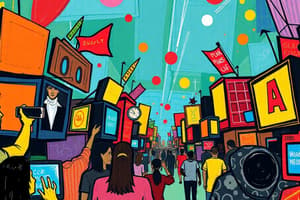Podcast
Questions and Answers
What is the primary function of communication as described?
What is the primary function of communication as described?
- To convey emotions through art.
- To manipulate opinions.
- To entertain an audience.
- To share information between a speaker and listener. (correct)
Which media type includes books and magazines according to the categorization of mass media?
Which media type includes books and magazines according to the categorization of mass media?
- Digital Media
- Broadcast Media
- Print Media (correct)
- Entertainment Media
What impact does mass media have on social awareness as stated in the content?
What impact does mass media have on social awareness as stated in the content?
- It hinders social connection.
- It promotes cultural isolation.
- It shapes social consciousness. (correct)
- It solely provides entertainment.
What cultural phenomenon is described as a new face of rap and traditional Filipino poetry?
What cultural phenomenon is described as a new face of rap and traditional Filipino poetry?
What is one reason people embrace new cultural expressions?
What is one reason people embrace new cultural expressions?
What does the term 'kakayahang pangkomunikatibo' refer to?
What does the term 'kakayahang pangkomunikatibo' refer to?
Which of the following best describes 'mass media'?
Which of the following best describes 'mass media'?
Which aspect of culture helps individuals cope with complex life situations according to the content?
Which aspect of culture helps individuals cope with complex life situations according to the content?
What does the 'Setting/scene' refer to in the SPEAKING model?
What does the 'Setting/scene' refer to in the SPEAKING model?
In the SPEAKING model, what do 'Participants' mean?
In the SPEAKING model, what do 'Participants' mean?
Which model emphasizes feedback and ongoing interaction between the communicator and the receiver?
Which model emphasizes feedback and ongoing interaction between the communicator and the receiver?
What aspect does 'Norms' cover in the SPEAKING model?
What aspect does 'Norms' cover in the SPEAKING model?
What is emphasized in the 'Ends' component of the SPEAKING model?
What is emphasized in the 'Ends' component of the SPEAKING model?
Which model proposes a visual representation to provide understanding of a concept?
Which model proposes a visual representation to provide understanding of a concept?
In the context of the SPEAKING model, what does 'Key' refer to?
In the context of the SPEAKING model, what does 'Key' refer to?
What characterizes the Transaksyonal Model of communication?
What characterizes the Transaksyonal Model of communication?
What does the term 'Kakayahang Pangkomunikatibo' primarily refer to?
What does the term 'Kakayahang Pangkomunikatibo' primarily refer to?
Which of the following is NOT one of the four elements of Kakayahang Pangkomunikatibo?
Which of the following is NOT one of the four elements of Kakayahang Pangkomunikatibo?
What aspects does 'Balarila' emphasize within language studies?
What aspects does 'Balarila' emphasize within language studies?
Which component does 'Sintaks' refer to in grammar?
Which component does 'Sintaks' refer to in grammar?
What is the purpose of 'Kakayahang Sosyolingwistiko'?
What is the purpose of 'Kakayahang Sosyolingwistiko'?
Which of the following best describes 'Ortograpiya'?
Which of the following best describes 'Ortograpiya'?
Which element of Kakayahang Pangkomunikatibo focuses on the effective use of language skills?
Which element of Kakayahang Pangkomunikatibo focuses on the effective use of language skills?
What is the relationship between phonetics and Kakayahang Lingguwistiko?
What is the relationship between phonetics and Kakayahang Lingguwistiko?
Flashcards
SPEAKING model
SPEAKING model
A model for analyzing discourse as a series of spoken acts within a cultural context, considering various factors like the situation, participants, and goals.
Setting/Scene (SPEAKING model)
Setting/Scene (SPEAKING model)
The time and place of communication, the general environment of the event.
Participants (SPEAKING model)
Participants (SPEAKING model)
The speaker and audience in a conversation. The audience are those the message is intended for.
Ends (SPEAKING model)
Ends (SPEAKING model)
Signup and view all the flashcards
Linear Communication Model
Linear Communication Model
Signup and view all the flashcards
Interactive Communication Model
Interactive Communication Model
Signup and view all the flashcards
Transactional Communication Model
Transactional Communication Model
Signup and view all the flashcards
Communication Model
Communication Model
Signup and view all the flashcards
Mass Media Categories
Mass Media Categories
Signup and view all the flashcards
Print Media
Print Media
Signup and view all the flashcards
Broadcast Media
Broadcast Media
Signup and view all the flashcards
Digital Media
Digital Media
Signup and view all the flashcards
Entertainment Media
Entertainment Media
Signup and view all the flashcards
Popular Culture
Popular Culture
Signup and view all the flashcards
Communication
Communication
Signup and view all the flashcards
Communicative Competence
Communicative Competence
Signup and view all the flashcards
Sociolinguistic Competence
Sociolinguistic Competence
Signup and view all the flashcards
What does 'communicative competence' refer to?
What does 'communicative competence' refer to?
Signup and view all the flashcards
What distinguishes 'communicative competence' from 'linguistic competence'?
What distinguishes 'communicative competence' from 'linguistic competence'?
Signup and view all the flashcards
What are the four key elements of Communicative Competence?
What are the four key elements of Communicative Competence?
Signup and view all the flashcards
What constitutes linguistic competence?
What constitutes linguistic competence?
Signup and view all the flashcards
What role does grammar play in linguistic competence?
What role does grammar play in linguistic competence?
Signup and view all the flashcards
What is orthography?
What is orthography?
Signup and view all the flashcards
Study Notes
Aralin 1: Mga Sitwasyong Pangwika sa Pilipinas
- Mass media categories (Rodman, 2007): Print media (books, magazines, newspapers), Broadcast media (radio, television), Digital media (computers, internet), and Entertainment media (films, recordings, video games).
- Popular culture is linked to technology's influence, commercialization, and easy reproduction of cultural expressions (magazines, comics, radio, television, films, clothing styles, graffiti, music, advertisements).
- Mass media shapes public awareness.
- Popular culture examples:
- Comics (popular in the 1920s, declined in the 1990s).
- Television dramas (became popular through radio dramas).
- Films (1950s saw rise of actors/directors, and independent films).
- Fliptop battle (a new form of rap and poetry).
- People embrace new cultural elements due to:
- Self-expression (thoughts, emotions).
- Simplifying complex experiences.
- Culture's role in navigating daily life.
- Entertainment and learning.
Aralin 2: Kakayahang Pangkomunikatibo ng Pilipino
- Communication (Latin: communicare – "to share") is a systematic method of information exchange between speaker and listener, using symbols, signs, and gestures.
- Communication competence is a learner's ability to use and understand language appropriately in various situations within and outside the school environment (Dell Hymes, 1966).
- Communication competence is distinct from Chomsky's linguistic competence (1965), incorporating contextual appropriateness.
- Four elements of communicative competence: linguistic, sociolinguistic, discourse, and strategic.
Aralin 3: Kakayahang Pangkomunikatibo ng Pilipino: Ang Modelong SPEAKING
- Dell Hymes' SPEAKING model analyzes discourse as a series of acts within a cultural context.
- Key components of SPEAKING model:
- Setting/scene
- Participants
- Ends
- Act sequence
- Key
- Instrumentalities
- Norms
- Genre
- Discusses the linear, interactive, and transactional models of communication.
Studying That Suits You
Use AI to generate personalized quizzes and flashcards to suit your learning preferences.




